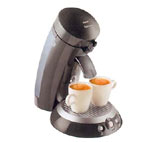Rituals of making espresso - Part one
Rituals of Making Espresso

Making espresso for your coffee drinks - cappuccino's, lattes, mochas, etc., requires that you understand the process or Ritual as I call it. The visual clue that tells us that we have achieved Java Heaven is called the "crema". The crema is that golden marbleized foam that covers the top of the espresso. Without waxing poetic which is often done in this business, the crema is simply nirvana. It's the foundation of the coffee culture that you have joined and the reason why you're reading and why I'm writing this "Understanding" segment. I know this may sound intimidating, but if you spend a little time learning you will be able to teach those Starbucks kids a thing or two in short order. The reason this is so important is because it is too easy to make a bad cup of coffee. With the proper knowledge you can break the mystique and brew high quality espresso in no time at all. So, grab a cup from that good old Mr. Coffee, sit down and read everything you need to know on brewing better coffee.
The Ritual
Extracting espresso is part "Art" and part "Science". The "Art" is understanding the nuances of
 your coffee, grinder and espresso machine. The "Science" is applying specific variables to the coffee roast, fineness of grind, tamp pressure, brewing temperature & pressure and time. The best method to learn how to make espresso is to begin with the science aspect. Identify the necessary variables and then apply the art aspect to fine tune the extraction (brewing). We break this mystique when we teach people everyday on how to "dial in" or "calibrate" their espresso machines. We begin with the "golden rule" of espresso making:
your coffee, grinder and espresso machine. The "Science" is applying specific variables to the coffee roast, fineness of grind, tamp pressure, brewing temperature & pressure and time. The best method to learn how to make espresso is to begin with the science aspect. Identify the necessary variables and then apply the art aspect to fine tune the extraction (brewing). We break this mystique when we teach people everyday on how to "dial in" or "calibrate" their espresso machines. We begin with the "golden rule" of espresso making:The Golden RuleDouble shot = 2 to 2.5 ounces in 20 to 25 seconds



